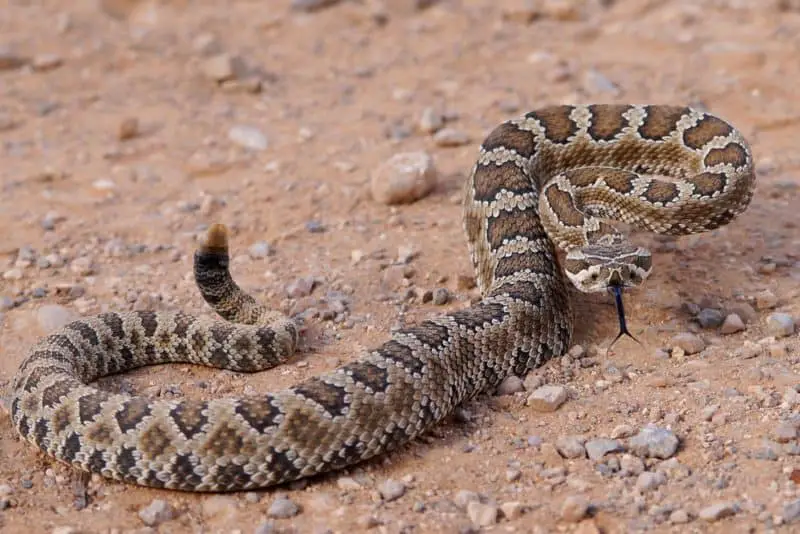There are two venomous snakes in Oregon. They’re both Western Rattlesnake subspecies. Western Rattlesnakes are the most widely distributed rattlesnakes in the western United States and Canada.
Oregon’s two Western Rattlesnake subspecies are the Northern Pacific Rattlesnake (Crotalus oreganus) and the Great Basin Rattlesnake (Crotalus oreganus lutosus). Both of these snakes play vital roles in the ecosystems in which they exist. This is mainly done by keeping rodent populations in check.
Unfortunately, both of Oregon’s venomous snakes are occasionally dangerous to humans. In an average year, around 14 people are bitten by venomous snakes in Oregon.
In this guide, we’ll tell you about the habitats and characteristics of Oregon’s venomous snakes. We’ll also tell you how to coexist with them as safely as possible in Oregon’s outdoors.
Pit Vipers: The Venomous Masters of Infrared Detection
Rattlesnakes, Copperheads, and Cottonmouths are among the most well-known members of the venomous Crotalinae subfamily of the Viperidae family of venomous snakes, also referred to as pit vipers. Since Oregon’s venomous snakes are both rattlesnakes, let’s learn about pit vipers.
What Makes Pit Vipers Unique?
- Infrared-Sensing Pits:
A defining feature of pit vipers is the deep facial pit between their nostril and the eye on each side of their head. These specialized infrared-detecting organs allow pit vipers to sense heat emitted by prey. This adaptation enables them to:- Detect body heat from up to 1 meter away.
- Strike prey with pinpoint accuracy, even in complete darkness.
- Triangular Heads and Vertical Pupils:
- Head Shape: Pit vipers are recognized by their distinct triangular-shaped heads, which house their venom glands.
- Eyes: They have vertical elliptical-shaped pupils.
- Venomous Fangs:
Pit vipers have hollow fangs connected to venom glands. These fangs fold back against the roof of their mouth when not in use. All pit vipers are born with multiple fangs and replace them every couple of months. Old fangs are shed one at a time. Consequently, a pit viper bite may only involve one fang. - Pit Viper Bites: Interestingly, these snakes have a sphincter on each venom gland. This allows them to control the flow of venom through the fangs. A snake may elect not to inject any venom with a bite. Scientists surmise that this is because it takes time for it to rebuild its venom store. Twenty to twenty-five percent of pit viper-to-human bites are dry bites.
Ecological Importance
Pit vipers play a crucial role in maintaining ecosystem balance by controlling rodent populations. Despite their fearsome reputation, these snakes are vital to the health of many habitats.
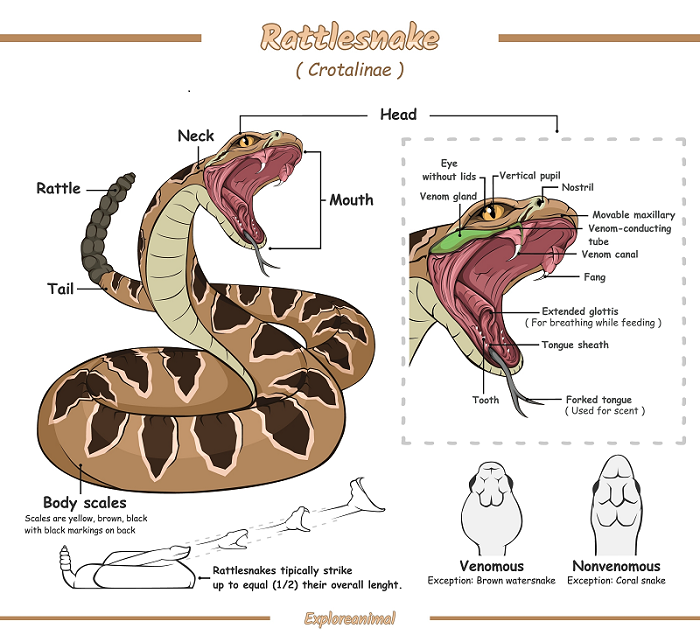
Rattlesnakes
- What Oregon’s rattlesnakes have in common with most other rattlesnakes is their rattle.
- Most rattlesnakes have a rattle at their tail’s end, comprised of hollow, loosely interlocked keratinous scales.
- Normally, a rattlesnake adds a new segment to its rattle each time it sheds its skin.
- An agitated rattlesnake rapidly vibrates its tail, causing the segments of its rattle to vibrate together, creating a buzzing or rattling sound.
- If you hear a rattling noise when you’re out in rattlesnake habitat, do not move until you spot where it originated. Otherwise, you may accidentally move into the snake, provoking it to strike you.
- You must be aware of where you are placing your hands and feet in rattlesnake country.
- Not all of Idaho’s rattlesnakes rattle before they strike. Sometimes, they lose their rattles due to injury, and sometimes, they choose not to rattle.
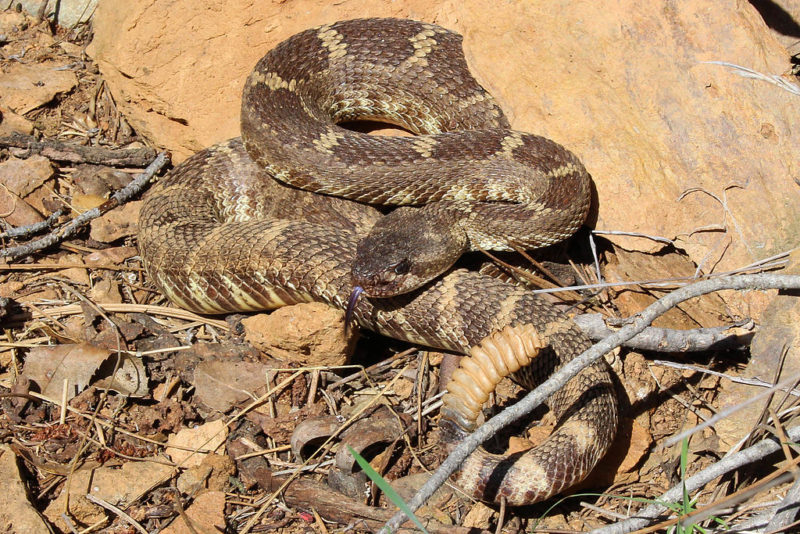
Northern Pacific Rattlesnake (Crotalus oreganus)
Another name for the Northern Pacific rattlesnake is the Western rattlesnake.
What Do Northern Pacific Rattlesnakes Look Like?
| Size | *Average adult snakes can grow to 39 inches (99cm) long. *The longest Northern Pacific rattlesnake on record is 64 inches (163cm). |
| Coloration | *Base colors: Dark brown, dark gray, or black. *Back: A covering of dark blotches with lighter edges runs along their backs. *Tail: Lighter-edged blotches turn into crossbands at the tail. The last two crossbands at the end of their tail are generally black. *Belly: Pale yellow with brown spots. |
| Face | *A dark brown stripe runs from behind each eye toward the mouth. *The dark brown stripe is outlined with lighter stripes on either side. |
| Conservation Status | *Species of Least Concern in Oregon. |
Where Do Northern Pacific Rattlesnakes Live?

Northern Pacific Rattlesnakes inhabit many of the drier regions of western North America. Their range extends from southwestern Canada to northern Mexico.
They occupy oak habitats in southwestern Oregon. This is in the Klamath/Siskiyou Mountain region and the Rogue River/ Umpqua Valleys. They also occupy the mid-to-southern Willamette Valley.
Northern Pacific Rattlesnakes are an Oregon conservation strategy species in the Willamette Valley. In northeastern and central Oregon, they live in juniper and pine woodlands. Visitors to Lake Billy Chinook sometimes run into Northern Pacific Rattlesnakes.
Northern Pacific Rattlesnake Brumation
To survive through the cool winter months, snakes and other reptiles brumate. They are ectotherms, which means they cannot regulate their body temperature internally. Physiologically, ectotherms cannot hibernate. Yet, they go into a state of suspended animation called brumation. Brumation is a reptile’s version of hibernation.
Northern Pacific Rattlesnakes brumate in communal dens of 10 to 50 snakes. Their snakelets leave their mother when they are a couple of weeks old. But they will follow her scent trail back to their wintertime den.
These dens are generally located in rocky crevices on south-facing slopes. These areas receive more direct sunlight. In northerly latitudes, they may brumate for up to six months out of the year.
They will also bask on the surface for 3 to 4 weeks before and after brumation. This helps to regulate their body temperature.
Be vigilant when hiking south-facing talus slopes in the early spring. You can stumble into a large group of these dangerous snakes. When warmer weather arrives, they will disperse until early September. In the Autumn, it’s wise to avoid these south-facing slopes once again.
How Dangerous Are Northern Pacific Rattlesnakes?
Northern Pacific rattlesnake venom has neurotoxic properties, along with hemotoxins and myotoxins.
Envenomation from one of these snakes may cause a multitude of symptoms. These include pain, swelling, fatigue, muscle weakness, body aches, and joint pain. In some cases, enlarged lymph nodes, anxiety, drowsiness, nausea, and diarrhea occur. Some of the systemic symptoms include neurological symptoms, internal hemorrhaging, and kidney failure.
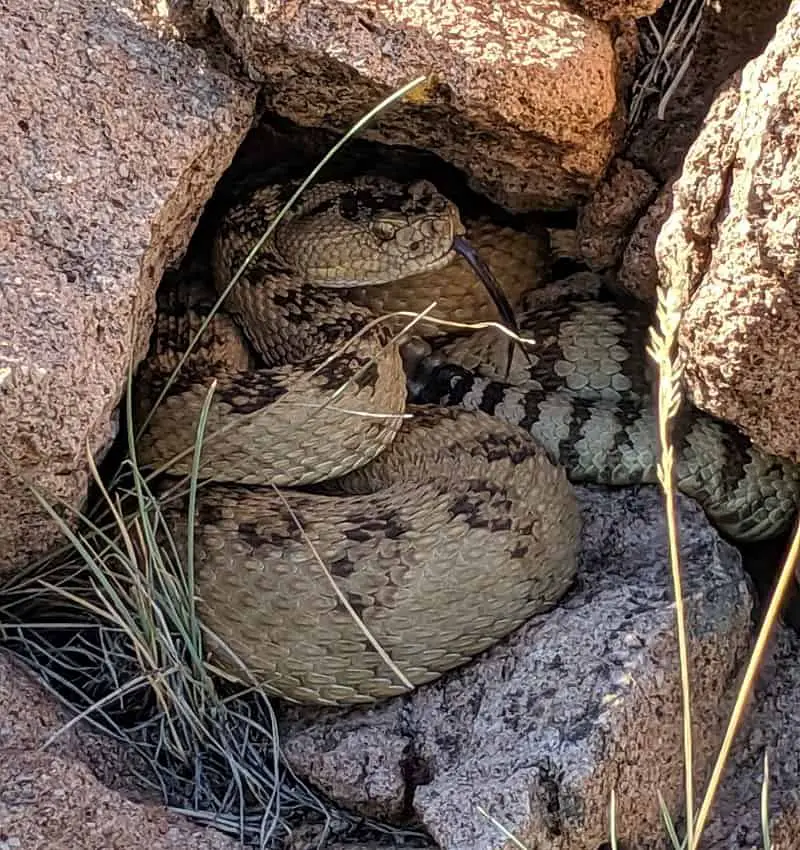
Great Basin Rattlesnake (Crotalus oreganus lutosus)
The Great Basin Rattlesnake is a subspecies of the western rattlesnake.
What Do Great Basin Rattlesnakes Look Like?
| Size | *Most Great Basin rattlesnakes are under 3 feet (0.91 m) in length. *The largest specimens can reach up to 4 feet (1.22 m). |
| Coloration | *Their bodies are light gray or light brown. |
| Dorsal Spots | *Dark blotches cover their bodies, typically dark brown to black with pale centers. |
| Conservation Status | *Common within their range. |
The Great Basin Rattlesnake is a subspecies of the Western Rattlesnake. They are predominantly native to the Great Basin. The Great Basin is the largest endorheic basin in North America. It takes in most of Nevada plus parts of Utah, Wyoming, Idaho, Oregon, and California.
Where Do Great Basin Rattlesnakes Live in Oregon?
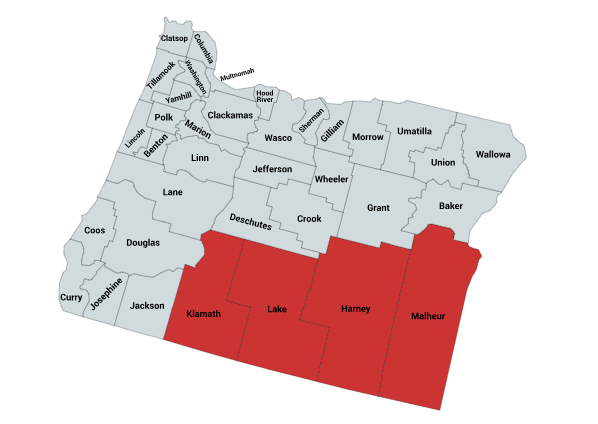
This is an article on the venomous snakes of Washington and Oregon. However, out of the two states, Great Basin Rattlesnakes only exist in Oregon. Specifically, they inhabit southern Oregon and eastern Oregon.
Great Basin Rattlesnakes exist in a wide variety of habitats. These include juniper woodlands, desert scrub, sagebrush flats, and rocky outcrops. Their buff-tan coloring and small, oval blotches match the arid surroundings there.
What Do Great Basin Rattlesnakes Eat?
Young Great Basin Rattlesnakes feed primarily on lizards and small rodents. As they mature, though, these snakes undergo ontogenetic change. Their prey preference shifts to mice, woodrats, and chipmunks.
Winter Brumation of Great Basin Rattlesnakes
Like Northern Pacific Rattlesnakes, Great Basin Rattlesnakes brumate in communal winter dens. These dens are ancestorial, and the snake tends to return to the same spot year after year. Since snakes don’t dig, these dens are in naturally sheltered areas such as rock fissures or caves. They are generally located on south or west-facing slopes, which receive more warmth from the sun.
How Dangerous Are Great Basin Rattlesnakes?
The Great Basin rattlesnake has a potent venom. It is a potent mix of myotoxins and hemotoxins. Their bites may produce pain, edema, nausea, and vomiting. Furthermore, the hemotoxic part of their venom can cause internal bleeding. This may lead to multiple organ damage. Moreover, the myotoxic part of their venom will produce necrosis of body tissue.
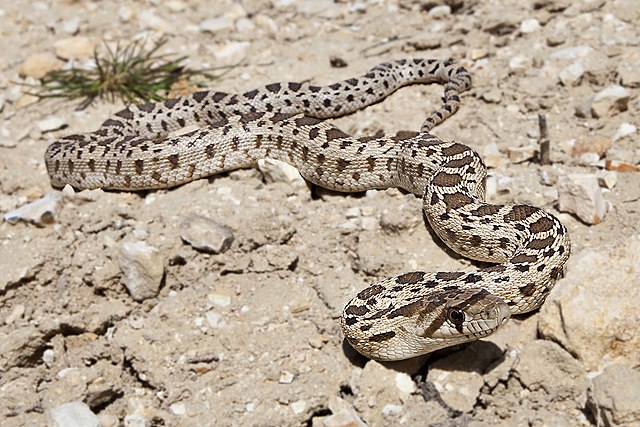
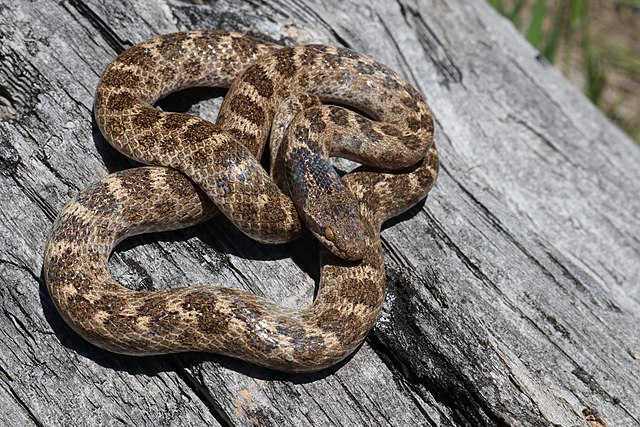
Rattlesnake Lookalikes
Gopher Snakes
Oregon is home to the gopher snake. People often mistake Gopher snakes, also called bull snakes, for rattlesnakes. This is primarily because they are similarly marked. Gopher snakes are nonvenomous snakes. But they can do a pretty fair rattlesnake impression when they’re agitated. They do this by coiling in a defensive posture and flattening out their heads. Occasionally, they even vibrate their tails. They don’t have a rattlesnake’s rattles, though.
Here’s a quote from the Oregon Department of Fish & Wildlife website. “The easiest way to tell a gopher snake from a rattlesnake is to look at the tail. Gopher snake tails come to a fine pint and lack rattles. Rattlesnakes have an obvious rattle that comes to a blunt end.”
In Oregon, there are two distinct subspecies of gopher snakes. First is the Pacific Gopher Snake. It inhabits the Willamette Valley and the southwest region. The second is the Great Basin Gopher Snake, which lives east of the Cascade Mountains. The hills around Klamath Falls have Great Basin Gopher snakes. They also have Northern Pacific Rattlesnakes.
Night Snakes
The Night Snake is another rattlesnake look alike. These are smaller snakes that are usually less than 18 inches (46 cm) in length. They have vertical elliptical pupils and are similarly marked to Western rattlesnakes. They do not have a rattle, though. A night snake’s saliva is mildly venomous. However, they’re not harmful to humans unless they produce an allergic reaction.
Rattlesnake Predators
Rattlesnake Predators That Are Immune to Rattlesnake Venom
Although they are venomous, Western Rattlesnakes do have some predators.
- Two of these are the California Kingsnake and the Common Kingsnake. Both snakes, which kill by constriction, are somewhat immune to snake venom.
- Skunks also prey on rattlesnakes. Fortunately for them, they are also immune to snake venom.
- Badgers also eat rattlesnakes and have some immunity to rattlesnake venom.
- Feral hogs are also immune to snake venom and find rattlesnakes to be tasty snacks.
Rattlesnake Predators That Are Not Immune to Rattlesnake Venom
The following animals occasionally prey on rattlesnakes but are not immune to their venom. They have to manage to kill the snake without being bitten.
- coyotes
- bobcats
- mountain lions
- raptors
Avoiding Snake Bite
Snakes, including venomous ones, commonly rely on their camouflage to avoid potential threats. They often remain perfectly still to avoid detection. If you’re walking in the woods and unknowingly get too close, a snake might not move, hoping you’ll pass by. Many bites happen when someone accidentally steps on or close to the snake. To stay safe in snake habitats, always watch where you step and where you place your hands.
Another common cause of snake bite is attempts to capture or kill a snake. Remember, venomous snakes can strike instantly, delivering a potentially life-threatening bite. The safest approach is to keep a safe distance and leave them alone.
Dressing for Snake Country
- High-top leather boots and long pants are both wise ideas.
- Also, wear loose-fitting denim. If there’s a gap before the snake’s fangs touch your skin, your chances of being envenomated are lower.
- In the absence of high-top leather boots, some people wear snake gaiters.
Symptoms of Venomous Snake Bites
Some of the symptoms you may experience from a venomous snake bite include:
- Discoloration in the area of the bite.
- Swelling in the area of the bite.
- Loss of muscle coordination.
- Tingling sensation in the area of the bite.
- Feeling nauseous.
- Having an abnormally rapid pulse.
What Should You Do If A Venomous Snake Bites You?
If you or someone you are with has suffered a venomous snakebite, time is of the essence. This is because the sooner a victim receives anti-venom, the less likely the venom in their body is to cause harm. In other words, it is important to seek immediate medical attention.
Do not attempt to kill the snake for identification purposes. This gives the snake a chance to bite you again. Also, consider that severed snakeheads can still bite and envenomate. If you have a phone, take a picture of the offending reptile. Otherwise, get started on your way to the hospital.
First Aid for Snake Bite Victims
- Remain calm and limit your movements. Do not run. If you must hike back to a vehicle, do it calmly and deliberately. Put as little stress on your heart as possible.
- Keep the area of the snake bite below the heart level and never above the heart level. Keeping the bite below the heart level will reduce the venom’s flow. However, holding the bite above your heart level will increase the venom’s flow.
- Remove all constricting items such as bracelets, watches, or rings before swelling occurs.
- Remember that using a cold compress on a venomous snake bite is not advisable. The cold may cause the local blood vessels to constrict and spread the venom faster.
- You can wash the affected area like any other wound with soap and water.
- You may cover the bite area with a moist dressing to reduce the swelling.
- Get medical help as soon as possible. Call the hospital to tell them a venomous snake has bitten you. So they can have anti-venom ready to give you when you arrive.
- A person whom a venomous snake has bitten may go into shock. If this happens, lay them flat and cover them with a blanket.
Conclusion
Oregon’s two venomous snakes, the Northern Pacific Rattlesnake and the Great Basin Rattlesnake are more than just fascinating reptiles. They are vital contributors to the state’s ecosystems. Lamentably, their venom makes them a potential hazard to humans. However, taking proper precautions and being aware of your surroundings reduces the risk of dangerous snake encounters or bites.
By learning to identify Oregon’s venomous snakes and understanding their behavior, you can explore the state’s stunning landscapes more safely. Always wear appropriate clothing in rattlesnake country, such as high-top leather boots and long pants. If a rattlesnake bite occurs, Utilize the first aid recommendations listed above and seek immediate medical attention.
3 Scorpions in Oregon – Krebs Creek
Wild Cats in Oregon – Krebs Creek
Recent Posts
The only venomous snakes in Washington State are Northern Pacific Rattlesnakes. The Northern Pacific Rattlesnake (Crotalus oreganus oreganus) is a sub-species of the Western Rattlesnake. Anyone...
Skunks are not classified as true hibernators. But they go into a state of torpor when the weather gets cold. Skunks are light sleep hibernators, along with opossums, bears, and raccoons. ...

